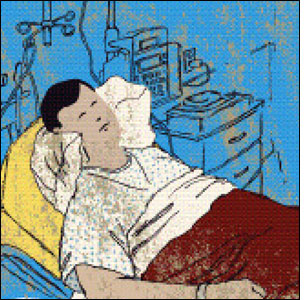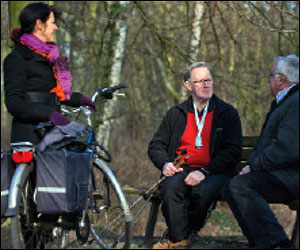Presented below is part 11 of an 11-part series examining the use of radio frequency identification for unexpected applications. In this chapter, we consider RFID’s use in patient care.
92. Reducing Cancer Patients’ Anxiety
The Roy and Patricia Disney Family Cancer Center, in Burbank, Calif., uses an RFID patient-tracking system to let patients manage their treatment experience. Each patient is issued an identification badge. As soon as patients enter the building, a concierge greets them by name and directs them to their appointments. When patients first visit some of the treatment rooms, a staff member helps them customize the environment to their liking. They can choose the room temperature, and one of six music selections, from rock to easy listening. Patients can also choose the room lighting—red, blue or orange—and opt to have beach, mountain or desert scenes displayed on the walls. (See RFID Helps Heal Body, Mind and Spirit.)
|
|
93. Cardiac Arrest? RFID Stat!
The Instituto do Câncer do Estado de São Paulo, in São Paulo, Brazil, is employing a Wi-Fi-based real-time location system to improve responsiveness when a patient goes into cardiac arrest. Staff members wear RFID badges. If someone witnesses a patient undergoing cardiac arrest, he or she can press one of two buttons on the tag—one for code blue, or another for code yellow. The RTLS alerts staff members and tracks response times, providing the clinic with information it can use to enhance its response processes. (See São Paulo Cancer Hospital Uses RFID to Respond to Heart Attacks.)
94. Caring for the Elderly
Rockhill Mennonite Community, an assisted-living and nursing facility in Pennsylvania, adopted a real-time location system to let management know when residents require assistance and to monitor the care they receive. Other long-term facilities provide memory-impaired residents with RFID tags or bracelets, so staff members can receive alerts when residents stray toward off-limits areas. (See Retirement Community Gains Insight From RTLS, Las Vegas-Area Nursing Facility Adopts RFID for Memory-Impaired Residents and Wi-Fi Tags Reduce Risk of Falling at Elder-Care Facility.)
95. No More Waiting
The waiting rooms at Apollo Hospitals Chennai, in India, and Virginia Mason Medical Center, in Washington State, are empty, though they each see hundreds of patients daily. That’s because both health-care facilities have adopted a real-time location system that tracks patients and staff members. Each system ensures that both patients and health-care workers are in the right examining and treatment rooms at the correct time. (See Apollo Hospital Chennai Uses RFID to Speed Up Check-Ups and At Virginia Mason Clinic, RFID Eliminates the Need to Wait.)
96. Kicking the Smoking Habit
The Scottish government is encouraging the use of National Entitlement Cards—contactless cards designed to reduce the handling of cash and promote public transit and other services. As part of that program, pregnant women can take a test at a pharmacy to determine whether they have been smoking. If they’re smoke-free, the pharmacy credits their cards with money that can be used to purchase food. (See RFID Helps Promote Healthy Pregnancies.)97. Symptom-Alerting Sensors
Some physical conditions can’t be readily detected in a doctor’s office, so researchers are developing RFID medical-monitoring tools that can track vital signs 24/7. Now, projects worldwide are proving that data collected by these tags and sensors can help physicians and other caregivers improve patient health and save lives.
Dutch nonprofit research institute IMEC-Nederland (IMEC-NL), a unit of the Holst Centre, an Eindhoven-based research institute for wireless solutions, has built several human body monitoring-system prototypes. The systems use RFID and wireless sensors to record and transmit data about a wearer’s vital signs to a central system, providing valuable clues about a patient’s physical condition. (Researchers at Michigan State University are developing similar systems to enable physicians or therapists to capture information about an individual’s expended energy, for sports-medicine or weight- management applications; see Michigan Researchers Develop RFID-Based Sensors to Measure Physical Activity.)
“For patient care, if you develop sensors that measure all kinds of physiological signals—like heart rate, blood pressure, muscle tension and movement and even maybe brain signals—you can combine this information and send it to a reader device, usually a mobile phone or laptop,” says Harmke De Groot, ultralow-power wireless and DSP program director at IMEC/Holst Center. “You can then analyze the data and do what we call personal health care.”
RFID technology allows caregivers to monitor readings associated with conditions including sleep apnea, pregnancy and heart disease, De Groot notes. Unlike information from in-clinic medical tests, RFID data can be collected continuously and stored unobtrusively under real-world conditions, then tapped for analysis whenever convenient. “There are quite a few arrhythmic [heart] problems known to only show up immediately after you stand up, or when you are really stressed or walking up stairs and things like that,” De Groot says. “If you have an electrocardiogram [RFID] patch sending all the data to your mobile phone and collecting it, then you can easily be monitored for a couple of days.”
Compact and wearable monitoring systems are also well suited for collecting data related to sudden-onset conditions, such as epileptic seizures. “You can, for example, detect if you’re going to have an epilepsy attack, which can really help patients and caregivers,” De Groot says.
Thanks to shrinking electronics, better batteries and diminishing costs, De Groot sees a day when RFID health systems will be integrated into clothing and personal accessories to provide 24-7 monitoring. “We can measure all kinds of physiological parameters that can warn you when something is not going well in your body, way before you notice the symptoms,” she says. “Very often, you think you are only a bit tired or not having such a good week or whatever, when you actually have symptoms.”Meanwhile, for patients with chronic conditions who currently must be evaluated several times a week or month, RFID monitoring promises both increased convenience and freedom. “It will actually improve the quality of life,” De Groot says. “I mean, we would all rather be at home than spend time in a hospital.”
98. At-Home Pain Management
Meridian Health, which operates five New Jersey hospitals and a home-care service, developed an RFID system to help patients with chronic disease live safely and independently at home. The Impak Health Journal for Pain has an active RFID tag that logs a patient’s reported pain, as well as the effectiveness of any medication he or she takes to reduce discomfort. When placed in an RFID reader, the information is uploaded to a database. Physicians can review the journal daily, to determine whether the medication needs to be adjusted or changed. (See RFID-Enabled Journal Helps Track Pain.)
99. Preventing Health-Care Acquired Infections
According to the World Health Organization, 5 percent to 15 percent of people in developed nations who are admitted to medical facilities end up with a health-care acquired infection (HCAI) that requires treatment, extending their hospital stays. Several RFID solution providers have developed hand-washing systems to increase compliance. Princeton Baptist Medical Center, in Birmingham, Ala., for instance, reports that it has seen a 36 percent reduction in patient visit time resulting from HCAIs since it began employing an RFID-based hand-washing compliance system in February 2010. (See RFID-Based Hand-Hygiene System Prevents Health-Care Acquired Infections, Patient-Safety Center Tests RFID-Enabled Hand Sanitizers and RFID Debuts as Hand-Washing Compliance Officer.)
100. Eliminating Treatment Mistakes
Radiation therapy can be an effective treatment for millions of cancer patients, but in recent years, there have been well-publicized cases of errors that resulted in serious injuries and deaths. Some of the most significant mistakes occurred because radiation therapists selected the wrong medical charts. Commonwealth Newburyport Cancer Center, in Massachusetts, is RFID-tracking patients to ensure they receive the proper treatment at every therapy session. When patients walk into any of the clinic’s procedure rooms, they are identified by an RFID reader and their medical chart and treatment plan are automatically opened on a computer screen, ready for use by a radiation therapist. (See RFID Makes Radiation Therapy Safer.)
101. Empowering Hospital Patients
Hospital “smart rooms” equipped with real-time location systems are designed to provide patients with a level of comfort. Before a doctor, nurse or clinician enters the room, the system reads their ID tag and displays their name, photo and brief bio on a wall-mounted monitor opposite the bed. The system also lets patients access education materials related to their diagnoses, and check their treatment schedules. Different systems are being used at MultiCare Health System’s Good Samaritan Hospital, in Washington; Fisher-Titus Medical Center and Magruder Hospital, both in Ohio; and ShadySide and Montefiore hospitals, both part of the University of Pittsburgh Medical Center. (See Health-Care Facilities Embrace RFID and MultiCare Health’s Good Samaritan Hospital to Install Smart Boards.)
Click here to read about RFID’s use in other unexpected applications.
Illustration: iStockphoto



